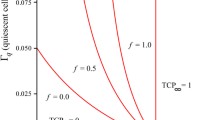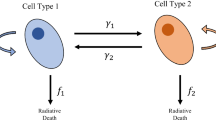Abstract
In this paper, the evolution of a tumour cord after treatment is investigated by extensive numerical simulations on the basis of a mathematical model developed by Bertuzzi et al. (submitted). The model is formulated in cylindrical symmetry adopting the continuum approach, and takes into account the influence of oxygen level on the proliferation and death rate of cells, the volume reduction due to disgregation of dead cells, and the cell killing effects of radiation and drugs. Some extensions of the model are proposed to represent more accurately the radioresistance of hypoxic cells and the cytotoxic action of anticancer drugs. The steady state of the cord, and the cord evolution from the steady state after the delivery of a single dose of an anticancer agent, are computed for various combinations of model parameters and for different choices of the functions describing the effects of treatments. The results of the numerical computations show that, in spite of its many simplifications, the model behaviour appears to be reasonable in view of the available experimental observations. The model allows having a better insight into some complex treatment-related events, such as cell reoxygenation and repopulation.
Similar content being viewed by others
References
Adam, J. A. and S. A. Maggelakis (1990). Diffusion regulated growth characteristics of a spherical prevascular carcinoma. Bull. Math. Biol. 52, 549–582.
Ambrosi, D. and L. Preziosi (2002). On the closure of mass balance models for tumour growth. Math. Models Methods Appl. Sci. 12, 737–754.
Bertuzzi, A., A. Fasano and A. Gandolfi (2000). A mathematical model for the growth of tumor cords incorporating the dynamics of a nutrient, in Free Boundary Problems: Theory and Applications II, N. Kenmochi (Ed.), Tokyo: Gakkotosho, pp. 31–46.
Bertuzzi A., A. Fasano and A. Gandolfi. A free boundary problem with unilateral constraints describing the evolution of a tumour cord under the influence of cell killing agents, submitted.
Bertuzzi, A., A. Fasano, A. Gandolfi and D. Marangi (2002). Cell kinetics in tumour cords studied by a model with variable cell cycle length. Math. Biosci. 177 & 178, 103–125.
Bertuzzi, A. and A. Gandolfi (2000). Cell kinetics in a tumour cord. J. Theor. Biol. 204, 587–599.
Bloor, M. I. G. and M. J. Wilson (1997). A mathematical model of a micrometastasis. J. Theor. Med. 1, 153–168.
Bloor, M. I. G. and M. J. Wilson (1999). The non-uniform spatial development of a micrometastasis. J. Theor. Med. 2, 55–71.
Boyer, M. J. and I. F. Tannock (1998). Cellular and molecular basis of chemotherapy, in The Basic Science of Oncology, I. F. Tannock and R. P. Hill (Eds), New York: McGraw-Hill, pp. 350–369.
Breward, C. J. W., H. M. Byrne and C. E. Lewis (2001). Modelling the interactions between tumour cells and a blood vessel in a microenvironment within a vascular tumour. Eur. J. Appl. Math. 12, 529–556.
Breward, C. J. W., H. M. Byrne and C. E. Lewis (2002). The role of cell-cell interactions in a two-phase model for avascular tumour growth. J. Math. Biol. 45, 125–152.
Bristow, R. G. and R. P. Hill (1998). Molecular and cellular basis of radiotherapy, in The Basic Science of Oncology, I. F. Tannock and R. P. Hill (Eds), New York: McGraw-Hill, pp. 295–321.
Brown, J. M. and B. G. Siim (1996). Hypoxia-specific cytotoxins in cancer therapy. Semin. Radiat. Oncol. 6, 22–36.
Byrne, H. M. and M. A. J. Chaplain (1995). Growth of nonnecrotic tumors in the presence and absence of inhibitors. Math. Biosci. 130, 151–181.
Byrne, H. M. and M. A. J. Chaplain (1996). Growth of necrotic tumors in the presence and absence of inhibitors. Math. Biosci. 135, 187–216.
Casciari, J. J., S. V. Sotirchos and R. M. Sutherland (1992). Variations in tumor cell growth rates and metabolism with oxygen concentration, glucose concentration, and extracellular pH. J. Cell. Physiol. 151, 386–394.
Chapman, J. D., D. L. Dugle, A. P. Reuvers, B. E. Meeker and J. Borsa (1974). Studies on the radiosensitizing effect of oxygen in Chinese hamster cells. Int. J. Radiat. Biol. 26, 383–389.
Cui, S. and A. Friedman (2001). Analysis of a mathematical model of the growth of necrotic tumors. J. Math. Anal. Appl. 255, 636–677.
Darzynkiewicz, Z., G. Juan, X. Li, W. Gorczyca, T. Murakami and F. Traganos (1997). Cytometry in cell necrobiology: analysis of apoptosis and accidental cell death (necrosis). Cytometry 27, 1–20.
Dyson, J., R. Villella-Bressan and G. Webb. The steady state of a maturity structured tumor cord cell population. Discrete Contin. Dynam. Systems B, to appear.
Falkvoll, K. H. (1990). The relationship between changes in tumour volume, tumour cell density and parenchimal cord radius in a human melanoma xenograft exposed to single dose irradiation. Acta Oncol. 29, 935–939.
Folkman, J. (1995). Angiogenesis in cancer, vascular, rheumatoid and other disease. Nat. Med. 1, 27–31.
Forrester, H. B., C. A. Vidair, N. Albright, C. C. Ling and W. C. Dewey (1999). Using computerized video time lapse for quantifying cell death of X-irradiated rat embryo cells transfected with c-myc or c-Ha-ras. Cancer Res. 59, 931–939.
Greenspan, H. P. (1972). Models for the growth of a solid tumor by diffusion. Stud. Appl. Math. 51, 317–340.
Hirst, D. G. and J. Denekamp (1979). Tumour cell proliferation in relation to the vasculature. Cell Tissue Kinet. 12, 31–42.
Hirst, D. G., J. Denekamp and B. Hobson (1982). Proliferation kinetics of endothelial and tumour cells in three mouse mammary carcinomas. Cell Tissue Kinet. 15, 251–261.
Hirst, D. G., V. K. Hirst, B. Joiner, V. Praise and K. M. Shaffi (1991). Changes in tumour morphology with alterations in oxygen availability: further evidence for oxygen as a limiting substrate. Br. J. Cancer 64, 54–58.
Holash, J., P. C. Maisonpierre, D. Compton, P. Boland, C. R. Alexander, D. Zagzag, G. D. Yankopoulos and S. J. Wiegand (1999). Vessel cooption, regression, and growth in tumors mediated by angiopoietins and VEGF. Science 284, 1994–1998.
Holmgren, L., M. S. O’Reilly and J. Folkman (1995). Dormancy of micrometastases: balanced proliferation and apoptosis in presence of angiogenesis suppression. Nat. Med. 1, 149–153.
Jackson, T. L. (2002). Vascular tumor growth and treatment: consequences of polyclonality, competition and dynamic vascular support. J. Math. Biol. 44, 201–226.
Jackson, T. L. and H. M. Byrne (2000). A mathematical model to study the effects of drug resistance and vasculature on the response of solid tumors to chemotherapy. Math. Biosci. 164, 17–38.
Jain, R. K. (1999). Transport of molecules, particles and cells in solid tumors. Annu. Rev. Biomed. Eng. 1, 241–263.
Joulia, J. M., F. Pinguet, M. Ychou, J. Duffour, D. Topart, P. Y. Grosse, C. Astre and F. Bressolle (1997). Pharmacokinetics of 5-fluorouracil (5-FUra) in patients with metastatic colorectal cancer receiving 5-FUra bolus plus continuous infusion with high dose folinic acid (LV5FU2). Anticancer Res. 17, 2727–2730.
Kyle, A. H. and A. I. Minchinton (1999). Measurement of delivery and metabolism of tirapazamine to tumour tissue using the multilayered cell culture model. Cancer Chemother. Pharmacol. 43, 213–220.
Lubkin, S. R. and T. Jackson (2002). Multiphase mechanics of capsule formation in tumors. J. Biomech. Eng. 124, 237–243.
Majno, G. and I. Joris (1995). Apoptosis, oncosis and necrosis. An overview of cell death. Am. J. Pathol. 146, 3–15.
McElwain, D. L. S. and P. J. Ponzo (1977). A model for the growth of a solid tumor with non-uniform oxygen consumption. Math. Biosci. 35, 267–279.
Montalenti, F., G. Sena, P. Cappella and P. Ubezio (1998). Simulating cancer cell kinetics after drug treatment: application to Cisplatin on ovarian carcinoma. Phys. Rev. E 57, 5877–5887.
Moore, J. V., P. S. Hasleton and C. H. Buckley (1985). Tumour cords in 52 human bronchial and cervical squamous cell carcinomas: inferences for their cellular kinetics and radiobiology. Br. J. Cancer 51, 407–413.
Moore, J. V., H. A. Hopkins and W. B. Looney (1980). Dynamic histology of a rat hepatoma and the response to 5-fluorouracil. Cell Tissue Kinet. 13, 53–63.
Moore, J. V., H. A. Hopkins and W. B. Looney (1983). Response of cell populations in tumor cords to a single dose of cyclophosphamide or radiation. Eur. J. Cancer Clin. Oncol. 19, 73–79.
Moore, J. V., H. A. Hopkins and W. B. Looney (1984). Tumour-cord parameters in two rat hepatomas that differ in their radiobiological oxygenation status. Radiat. Environ. Biophys. 23, 213–222.
Sena, G., C. Onado, P. Cappella, F. Montalenti and P. Ubezio (1999). Measuring the complexity of cell cycle arrest and killing of drugs: kinetics of phase-specific effects induced by taxol. Cytometry 37, 113–124.
Smith, G. D. (1965). Numerical Solution of Partial Differential Equations, London: Oxford University Press.
Tannock, I. F. (1968). The relation between cell proliferation and the vascular system in a transplanted mouse mammary tumour. Br. J. Cancer 22, 258–273.
Tannock, I. F. (2001). Tumor physiology and drug resistance. Cancer Metastasis Rev. 20, 123–132.
Tannock, I. and A. Howes (1973). The response of viable tumor cords to a single dose of radiation. Radiat. Res. 55, 477–486.
Ward, J. P. and J. R. King (1997). Mathematical modelling of avascular-tumour growth. IMA J. Math. Appl. Med. Biol. 14, 39–69.
Ward, J. P. and J. R. King (1999). Mathematical modelling of avascular-tumour growth II: modelling growth saturation. IMA J. Math. Appl. Med. Biol. 16, 171–211.
Ward, J. P. and J. R. King (2003). Mathematical modelling of drug transport in tumour multicell spheroids and monolayer cultures. Math. Biosci. 181, 177–207.
Webb, G. F. (2002). The steady state of a tumor cord cell population. J. Evolut. Equat. 2, 425–438.
Author information
Authors and Affiliations
Corresponding author
Rights and permissions
About this article
Cite this article
Bertuzzi, A., D’Onofrio, A., Fasano, A. et al. Regression and regrowth of tumour cords following single-dose anticancer treatment. Bull. Math. Biol. 65, 903–931 (2003). https://doi.org/10.1016/S0092-8240(03)00054-5
Received:
Accepted:
Issue Date:
DOI: https://doi.org/10.1016/S0092-8240(03)00054-5




